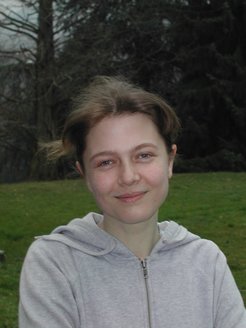Alumni 2008
Xuepeng Chen (7.2.) - Markus Janson (30.4.) - Dominikus Heinzeller (16.7.) - Irina Golombek (16.10.) - Michael Zatloukal (22.10.) - Oscar Esquivel (12.11.) - Steve Boudreault (20.11.) - Giulia Vannoni (27.11.) - Svitlana Zhukovska (17.12.) - Pak Hin Tam (17.12.)
Pak Hin Tam (Hong Kong) 17.12.2008

Gamma-ray burst studies using the H.E.S.S. Cherenkov array (thesis pdf)
Gamma-ray bursts (GRBs) are the most intense and unpredictable gamma-ray events from the Universe. Without prior signal, an enormous amount of energy is released for seconds, energizing particles and generating the observed 10e5-10e6 eV gamma-ray photons. The emitting regions can produce Very-High-Energy (VHE) gamma-ray photons of energy about 10e11 eV during and after the burst. These VHE gamma-rays may be attenuated in the source or by the extragalactic background light (EBL). The H.E.S.S. array of four imaging atmospheric Cherenkov telescopes (IACT) is sensitive to VHE gamma-rays. H.E.S.S. observations of 34 GRBs were carried out during 2003-2008, with the shortest response time being six minutes. No evidence of VHE gamma-rays was found. Flux upper limits derived for GRB030329 and GRB060505 are compared and are found consistent with the synchrotron self-Compton flux calculated in the context of relativistic blast-wave model. Absorption by EBL was taken into consideration. Accidentally, GRB060602B was observed with H.E.S.S. throughout the GRB duration, during which no signal of VHE gamma-rays was found. The distance scale and origin of GRB060602B remain unclear and different possibilities and implications are presented. Future prospects of VHE gamma-ray observations of GRBs are discussed
Supervisor: Stefan Wagner (LSW)
Svitlana Zhukovska (Ukraine) 17.12.2008

Dust formation by stars and evolution in the interstellar medium (thesis pdf)
The main goal of this thesis is the study of the origin and evolution of interstellar dust in the Milky Way. We develop a model for the chemical evolution of the galactic disk as a basis for our new model of dust evolution, which considers for the first time the individual evolutions of stardust and of dust condensed in molecular clouds of the Galactic disk. We include dust production by AGB stars in detail, using the results of synthetic AGB models combined with models of dust condensation in stellar outflows, and estimate the efficiency of dust condensation in supernovae by matching model results for the Solar neighbourhood with observed abundances of presolar dust grains of supernova origin. Our results indicate that supernovae produce mainly carbon dust, with only small amounts of silicates, iron and silicon carbonate. We show that the interstellar dust population is dominated by dust grown in the interstellar medium across the Galactic history; moreover, dust formed in AGB stars and supernovae is a dominant source of dust only at metallicities lower than the minimal value for efficient dust growth in molecular clouds.
Supervisor: Hans-Peter Gail (ITA)
Giulia Vannoni (Italy) 27.11.2008

Diffusive Shock Acceleration in Radiation Dominated Environments (thesis pdf)
In this work I describe a numerical method developed, for the first time, for the study of Diffusive Shock Acceleration in astrophysical environments where the radiation pressure dominates over the magnetic pressure. This work is motivated by the overwhelming evidence of the acceleration of particles to high energy in astrophysical objects, traced by the non–thermal radiation they emit due to interactions with the gas, radiation fields and magnetic fields. The main objective of this work is to create a generic framework to study self–consistently the interaction of acceleration at shocks and radiative energy losses and the effect such an interplay has on the particle spectrum and on the radiation they emit, in the case when energy losses determine the maximum achievable energy. I apply the developed method to electrons accelerated in three different types of sources: a Supernova Remnant in the Galactic Centre region, a microquasar, and a galaxy cluster. In all three cases the energy losses due to the interaction of electrons with radiation dominate over synchrotron cooling. I demonstrate that there is a strong impact due to the changing features of the inverse Compton scattering from the Thomson to the Klein-Nishina regime, on both the spectrum of accelerated electrons and their broadband emission. I also consider proton acceleration in galaxy clusters, where the particles lose energy during acceleration due to the interaction with the Cosmic Microwave Background radiation. The secondary products from pair production and photomeson processes interact with the same photon field and the background magnetic field, producing broadband electromagnetic radiation from radio to gamma-rays.
Supervisors: Felix Aharonian / Werner Hofmann (MPIK)
Steve Boudreault (Canada) 20.11.2008

The formation of brown dwarfs as revealed by the mass function of IC 2391 (thesis pdf)
This PhD thesis deals with the formation and evolution of brown dwarfs. Here, we present the stellar and substellar mass function of the open cluster IC2391, plus its radial dependence, and use this to put constraints on the formation mechanism of brown dwarfs. Our multiband optical and infrared photometric survey with spectroscopic follow up covers 11 square degrees, making it the largest survey of this cluster to date. We observe that there is no variation in the mass function over the stellar/substellar boundary at all three cluster radius intervals analyzed. From this lack of discontinuity, we conclude that the stellar embryo ejection mechanism cannot be the unique brown dwarf formation path if this formation mechanism produces a higher velocity dispersion for brown dwarfs than the stars obtain. Alternatively, the ejection mechanism could be a dominant brown dwarf formation path only if it produces the same velocity dispersion for brown dwarfs as exists for stars in the cluster. In addition, we observe a radial variation in the mass function over the range 0.15 to 0.5 M_sun. We conclude that this is a signature of mass segregation via dynamical evolution. Analysis of mass functions of other open clusters from different ages and environment, at each side of the stellar/substellar boundary, also indicates that dynamical evolution influences the shape of the mass function.
Supervisor: Coryn Bailer-Jones (MPIA)
Oscar Esquivel (Mexico) 12.11.2008

Aspects of wave mechanics of gravitating systems (thesis pdf)
The Jeans instability of a galactic disk embedded in a dynamically responsive dark-matter halo is investigated in this work. On small scales the instability is suppressed, if the Toomre stability index Q_T is higher than a certain threshold, but on large scales the Jeans instability sets invariably in. However, using a simple self-consistent disk-halo model it is demonstrated that this occurs on scales which are much larger than the system so that this is indeed only a nominal effect. Also, a rigorous calculation of the dynamical friction (DF) force exerted on a Plummer and a Hernquist sphere moving through an infinite homogenous system of field stars is presented. By using a wave-mechanical treatment, we recover Chandrasekhar's drag force law with a modified Coulomb logarithm that depends on the exact shape of the perturber. We then extend this mode analysis to anisotropic velocity distributions of the field stars. We present easy-to-use handy formulae of the DF force exterted on a point-mass satellite for the cases when the velocity ellipsoid is either oblate or prolate for different values of the effective velocity dispersion sigma_eff determining the anisotropy of the host system.
Supervisor: Burkhard Fuchs (ARI)
Michael Zatloukal (Germany) 22.10.2008

A search for distant galaxy clusters (thesis pdf)
The evolution of galaxy clusters and their members above z >= 1 is largely unclear at present due to the small number of known distant clusters. To probe this important period and witness the development of key cluster characteristics observed today, the HIROCS survey is establishing a statistically signicant 0.5 <= z <= 1.5 cluster sample. For this thesis, the HIROCS cluster selection function was studied in detail using a mock sky based on semi-analytical galaxy evolution simulations. Public and proprietary data were combined for the COSMOS field. A cluster search was performed, yielding a 0.5 <= z <= 1.59 catalog of clusters, including the irst larger, uniformly selected sample of distant (z > 1.2) clusters published. Comparing the color evolution of X-ray bright and -dark clusters, the latter were found to contain fewer passive galaxies than their X-ray counterparts. Spectroscopic follow-up observations of four z~0.85 candidates, three of them X-ray dark, were conducted to probe cluster detection biases related to this. Using the distant cluster sample, it was shown that z >= 1.2 clusters predominantly contain blue galaxies with active star formation and a significant fraction of interacting members, but that their early type galaxies are old and formed the bulk of their stars at zf >= 3, possibly zf >= 5, in excellent agreement with predictions from simulations.
Supervisor: Hermann-Josef Röser (MPIA)
Irina Golombek (Germany) 16.10.2008

Non-thermal emission of galaxy clusters (thesis pdf)
We investigate the numerical modelling of relativistic protons, so-called cosmic rays, in a magnetised plasma. For the first time we combine two different components of a cosmological simulation code that so far have only been tested and employed independently of each other. By means of magnetohydrodynamic shock tube calculations in a gas that contains a constant fraction of relativistic particles we check for the correct physical behaviour of the combined numerical models. For this purpose we derive an analytical expression for the magnetosonic shock and rarefaction waves in the MHD Riemann problem and solve for the resulting system of equations using an iterative scheme. Comparing the theoretical and numerical solutions of a number of shock tube calculations we assess the physical correctness of the simulation. After successful testing we simulate the structure formation of three galaxy clusters including the consistent modelling of magnetic fields and cosmic rays. By means of analytical models we compute the X-ray and radio emission of the simulated clusters and reveal the temporal correlation between both quantities. Through a comparison with the strong lensing cross sections we demonstrate that the observable radio emission of galaxy clusters is directly connected to the occurrence of substructure in their dark matter halos and is thus triggered by strong merger shocks.
Supervisor: Matthias Bartelmann (ITA)
Dominikus Heinzeller (Germany) 16.07.2008

Mass and energy balance in accretion disks (thesis pdf)
We study the role of convection in black hole accretion flows. We investigate the influence of convection on the energy transport as well as the effect of convective turbulence on the disk’s viscosity. The results reveal that convection supports the radiative energy transport efficiently in massless disks, while it can turn into a negative feedback if self-gravity becomes important. Convective turbulence adds significantly to the total viscosity, but cannot account for it on its own. In the second part, we study the spectral energy distribution of super-Eddington accretion flows onto a black hole, based on 2D RHD simulation data. We model the continuum emission as well as the iron K line emission and absorption features with a ray-tracing radiative transfer code. We find that mild relativistic beaming effects become important, leading to super-Eddington luminosities for face-on seen disks. We confirm the diagnostic power of the iron K lines on the accretion process in the inner disk region, finding a strong correlation between the central black hole mass and the ratio of the K-alpha to the K-beta lines. We also detect a trend of line broadening for edge-on seen disks.
Supervisor: Wolfgang Duschl (ITA; Kiel University)
Markus Janson (Sweden) 30.04.2008

Direct imaging search for substellar companions to nearby stars (thesis pdf)
Ever since the first detections of extrasolar planet candidates in the early 1990s, our knowledge of such objects has drastically increased, and exoplanet science today constitutes a major branch of astrophysics, with a few hundred individual detections. Our physical understanding is however limited by the fact that the planets are generally only detected indirectly, with just a few constraints on its orbital and physical parameters. Direct imaging of exoplanets, where the planet can be spatially resolved from the star, opens up for a much broader understanding of these objects, with the opportunity to study their spectral characteristics. Alternatively, eclipse spectroscopy, where the planetary signal can be temporally resolved in systems where the orbital plane of the planet happens to align with the line of sight of an observer, can be used for the same purpose. In this thesis, we study various approaches for direct imaging and spectroscopy of exoplanets from the ground, using combinations of adaptive optics and differential methods, in particular spectral and angular differential imaging. The possibility of using an external occulter for the purpose of decreasing the star-planet contrast is studied. We also investigate the possibility to calibrate theoretical mass-luminosity relationships in order to improve detection predictions and the interpretations of null-detection surveys. Scientific results include an improved age range of the AB Dor system thanks to the spatial distinguishing of AB Dor B as a close binary, and the best constrained upper limit to the H-band brightness of any known exoplanet ever achieved, from a deep imaging search for Eps Eri b.
Supervisors: Wolfgang Brandner / Thomas Henning (MPIA)
Xuepeng Chen (China) 07.02.2008

High angular resolution observations of binary protostars (thesis pdf)
In this thesis I present a systematic effort to reveal the physical processes that lead to the formation of binary stars. We have observed, at high angular resolution, thirteen isolated low-mass protostellar cores, using the Owens Valley Radio Observatory millimeter array, the Australia Telescope Compact Array, and the IRAM Plateau de Bure Interferometer array. The observations were mainly carried out in the N2H+(1-0) line and at 3mm dust continuum. The results were complemented by infrared data from the Spitzer Space Telescope and the ESO Very Large Telescope. We find that binarity/multiplicity is frequent in the protostellar phase, though it is too early to derive a separation distribution. The circumstellar mass ratio distribution of binary protostars appears to be flat like that of more evolved long-period main-sequence binary stars, and more than 75% of protobinary systems have circumstellar mass ratios below 0.5. The specific angular momenta of protostellar cores are intermediate between those of prestellar cores and the orbital angular momenta of wide pre-main sequence binary systems. There appears to be no significant decrease of angular momentum between the onset of the protostellar collapse and the emergence of a binary star, which suggests that most of the angular momentum contained in the collapse region is transformed into orbital angular momentum of the resulting stellar binary system. We find that during core fragmentation the angular momentum is not evenly, in value and direction, divided between sub-cores. Furthermore, most cores with binary protostars have ratios of rotational to potential gravitational energy of beta_rot > 1%. This is consistent with theoretical simulations and suggests that the initial amount of rotational energy in a molecular cloud core is playing an important role in the protostellar fragmentation process.
Supervisors: Ralf Launhardt / Thomas Henning (MPIA)









